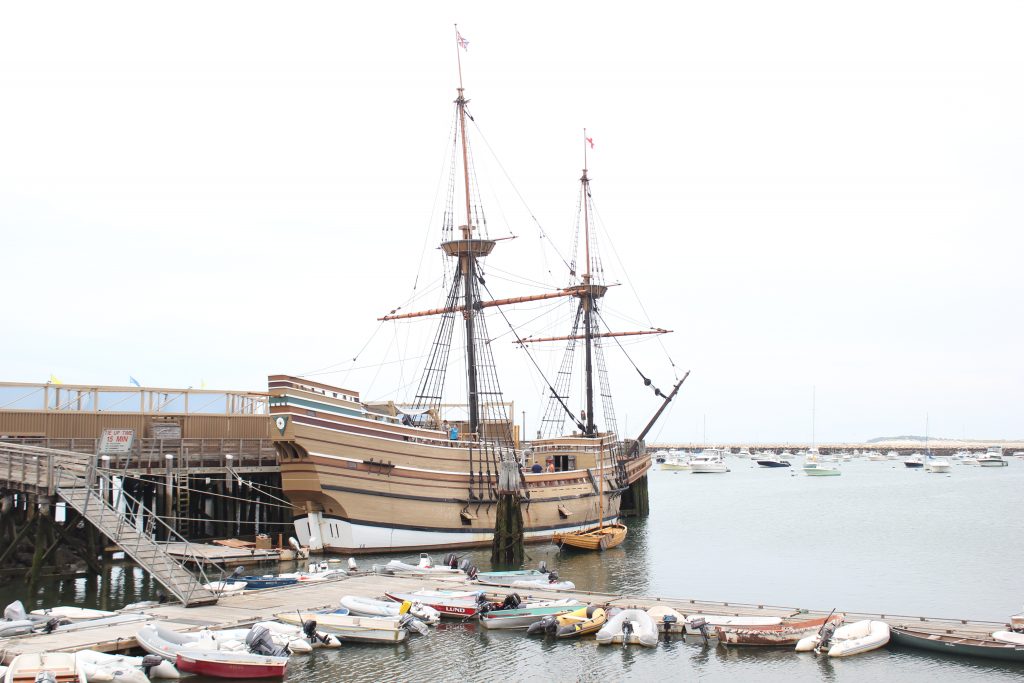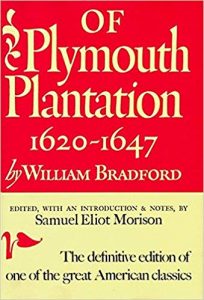
The Pilgrims’ 400th Anniversary Year
It’s February 2020. This next November, it will be 400 years since the Mayflower rounded “the fist” of Cape Cod’s flexed arm and found their first safe harbor near today’s Provincetown. In December, it will be 400 years since the Mayflower crew and passengers, after some exploration, anchored their ship in Plymouth Bay and sent men ashore in the shallop (for the second time) with intent to settle the place called Patuxet by the Wampanoags.
From the Pilgrims’ copy of Captain John Smith’s map of New England (named by him in 1614), the group knew this place, new and strange to them, by a familiar name ~ Plimouth (or New Plimouth). Smith had called it Accomack, but allowed Prince Charles to rechristen a number of places on the map with English names. Thus, today we have Plymouth, the Charles River, Cape James, and Cape Anne (for the prince’s mother, the Queen) to list a few.
So, the Pilgrims did not name Plymouth. It was named that four years earlier in 1616, shortly before the publication in July of that year of Smith’s A Description of New England: or the Observations and Discoveries of Captain John Smith (Admiral of That Country) in the North of America in the Year of Our Lord 1614. [Smith’s voyage was in 1614, the publication in 1616.]This fascinating and extremely valuable document is available as the scanned original (with map) online at Archive.org and in convenient PDF (no map) courtesy of Digital Commons, Libraries of University of Nebraska-Lincoln.
Particular Plantation Grants in America
So, what were the Pilgrim Fathers up to four centuries ago in this month of February? They were receiving, from the Virginia Company of London, by way of John Pierce, a citizen and clothier of London, a second patent for a “Particular Plantation” in Virginia. It replaced the Wincop Patent granted in 1617. The English colony of Virginia stretched from 34° latitude (through modern South Carolina) north to 45° latitude (just north of modern-day Bangor, Maine). It was divided between the London Company ~ 34° to 41° ~ which would have included Manhattan and Long Island, and the Plymouth (England) Company ~ 38° to 45°. Within the three-degree overlap, 38 to 41, settlements were to have 100 miles of separation. As the mouth of the James River is about 37° latitude, Jamestown Colony was part of the London Company.
Particular Plantations, called “Hundreds” in Jamestown, consisted of large tracts ~ thousands of acres ~ offering fishing and trading rights and local self-government to those who would people and cultivate the grant. On that same day that the Pilgrims received their second patent, February 2, 1620, the Virginia Company “passed a very liberal ordinance for Particular Plantations, giving their captains or leaders…almost complete autonomy within the Virginia Colony.” (SEM, OPP, pg. 39 note 6) The right to run their affairs as they saw fit and control the environment of their new life was vital to the Separatist “Puritan” Pilgrims. It was what drove them to undertake such a risky, perilous, and difficult adventure, across a dangerous ocean to a virtually unknown and potentially hostile land.
This congregation called themselves simply “God’s People.” The label Puritan was actually a pejorative, applied by the Anglican government. Why do we call them Pilgrims? The clue is in Bradford’s journal and commented on in Morison’s edition. More to come on those issues.
Virginia? Weren’t They Going to Plymouth?
 In his journal, Of Plymouth Plantation, Pilgrim leader William Bradford wrote that they intended to “find some place about Hudson’s River for their habitation.” (SEM, OPP, pg. 60) So America’s famous founding fathers and mothers, the Pilgrims, were headed for modern-day New York State and the Hudson River? And not Massachusetts in New England? Why? And how did they end up in Plymouth, northwest of Cape Cod? And what would have happened had they gone to the Hudson?
In his journal, Of Plymouth Plantation, Pilgrim leader William Bradford wrote that they intended to “find some place about Hudson’s River for their habitation.” (SEM, OPP, pg. 60) So America’s famous founding fathers and mothers, the Pilgrims, were headed for modern-day New York State and the Hudson River? And not Massachusetts in New England? Why? And how did they end up in Plymouth, northwest of Cape Cod? And what would have happened had they gone to the Hudson?
We’ll entertain those questions in our next “installment” regarding the Year of the Mayflower. The references given are from Of Plymouth Plantation 1620 to 1647, by William Bradford, edited with an introduction and notes by Samuel Eliot Morison, 1952. We’ll talk more about the professor and admiral in another “installment.” His is my favorite edition of Bradford’s journal and I highly recommend it.

